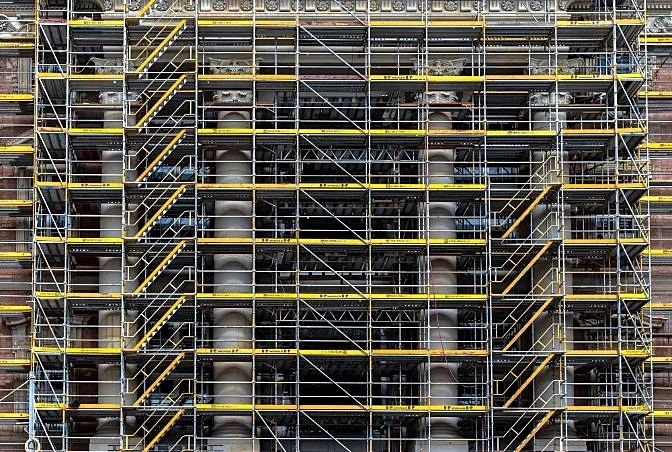High-Quality Residential Scaffolding for Seamless Home Renovations in Surrey
High-Quality Residential Scaffolding for Seamless Home Renovations in Surrey
Blog Article
Exploring the Various Kinds Of Scaffolding Used in Construction Jobs
The building and construction industry depends heavily on different kinds of scaffolding to fulfill specific job requirements, each offering distinctive advantages and applications. Typical framework scaffolding provides a strong structure for general tasks, while put on hold scaffolding is important for work on high-rise frameworks.

Standard Structure Scaffolding
Conventional frame scaffolding is one of the most widely utilized methods in the building and construction market because of its robustness and versatility. This system consists of straight and vertical structures that are put together to create a secure platform for workers and materials. The primary elements consist of vertical posts, horizontal journals, and angled dental braces, which together offer a solid framework that can support substantial tons.
Among the key benefits of traditional frame scaffolding is its versatility to numerous building tasks, varying from residential buildings to huge business structures. The modular layout permits very easy assembly and disassembly, making it reliable for both temporary and lasting tasks. In addition, the system can be customized in height and width, accommodating various structure designs and site conditions.
Safety is vital in scaffolding applications, and traditional structure systems are outfitted with guardrails and toe boards to avoid falls and guarantee worker security. Furthermore, regular inspections and adherence to safety and security regulations are crucial in keeping the stability of the scaffold. In general, typical frame scaffolding stays a basic option in the building and construction market, supplying a reputable platform for labor and enhancing overall job effectiveness

Suspended Scaffolding
Put on hold scaffolding provides an one-of-a-kind solution for building and construction projects that need access to raised surfaces, specifically in situations where traditional framework scaffolding may be unwise. This sort of scaffolding is generally put on hold from the roofing or upper levels of a framework, using a system of ropes, pulley-blocks, and systems to create a working area that can be adapted to different elevations.
One of the main benefits of suspended scaffolding is its versatility. It can be conveniently repositioned or lowered to accommodate adjustments in building and construction needs, making it ideal for tasks such as home window installation, frontage job, and upkeep on skyscraper structures. Additionally, the very little impact of suspended scaffolding permits far better usage of ground room in urban settings, where room is typically minimal.
Safety is a critical factor to consider in the use of put on hold scaffolding. On the whole, put on hold scaffolding offers a efficient and effective option for accessing hard-to-reach locations in various construction situations, improving both efficiency and safety on site.
System Scaffolding
System scaffolding, usually considered a modern-day solution in the scaffolding sector, is composed of pre-engineered parts that can be quickly set up and adapted for various building projects. Scaffolding. This kind of scaffolding is defined by its modular style, which permits for versatility and efficiency on job websites, accommodating different heights and architectural requirements
Commonly made from high-strength steel or aluminum, system scaffolding supplies improved durability and security. The parts include upright messages, horizontal ledgers, and angled dental braces, which interconnect securely, making certain a robust framework. The layout frequently incorporates standardized installations, simplifying setting up and disassembly processes, thus lowering labor time and prices.

Rolling Scaffolding
Moving scaffolding is a functional option to traditional set scaffolding, developed for flexibility and convenience of usage on building and construction websites. This kind of scaffolding includes a system sustained by structures with wheels, enabling workers to quickly move it as required. The wheelchair feature dramatically enhances efficiency, as it lessens downtime associated with setting up and dismantling taken care of scaffolding.
Usually constructed from lightweight materials such as light weight aluminum or steel, rolling scaffolding supplies a strong yet mobile option for projects requiring regular repositioning - Scaffolding. It is particularly useful in tasks such as paint, drywall setup, next and electrical job, where access to numerous elevations and locations is essential
Safety is paramount in rolling scaffolding design, with functions such as locking wheels to stop unintentional activity when being used, and guardrails to safeguard employees from falls. Furthermore, numerous versions are flexible in elevation, suiting numerous job requirements.
Cantilever Scaffolding

The style of cantilever scaffolding typically includes utilizing brackets or arms secured to a structure or framework, allowing the system to extend external securely. Security is extremely important; therefore, these scaffolds have to be crafted to stand up to different loads and ecological problems. Routine examination and maintenance are necessary to make certain structural honesty and worker security.
Cantilever scaffolding is favored for its flexibility and efficient use of area, making it a prominent option in city atmospheres where area restraints are common. Additionally, it helps with less complicated access to high elevations, eventually adding to the general efficiency of construction projects. Just like all scaffolding types, appropriate training and adherence to safety criteria are important for workers making use of cantilever scaffolding.
Final Thought
Conventional framework scaffolding supplies stability, while put on hold scaffolding supplies versatility for raised tasks. System scaffolding helps with quick assembly, and rolling scaffolding boosts flexibility for differing work moved here environments.
Traditional frame scaffolding provides a sturdy foundation for general jobs, while suspended scaffolding is necessary for work on skyscraper structures.Rolling scaffolding is a flexible option to standard set scaffolding, made for movement and simplicity of use on building websites. As with all scaffolding types, appropriate training and adherence to safety standards are vital for workers making use of cantilever scaffolding.
Standard framework scaffolding gives security, while put on hold scaffolding supplies convenience for raised jobs. System scaffolding scaffold ratchet promotes quick assembly, and rolling scaffolding boosts movement for varying job environments.
Report this page